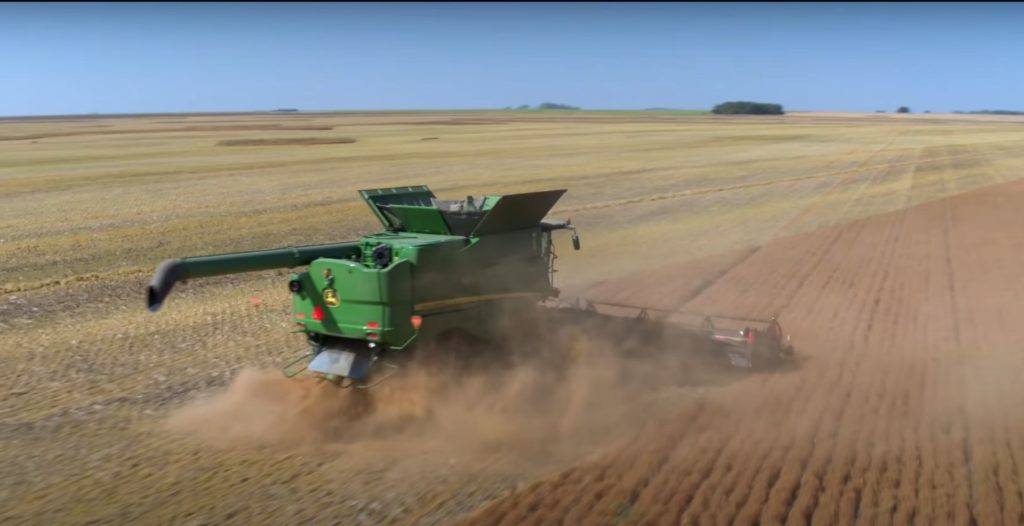Article contributed by lentils.
Lentils are part of the pulse crop family, alongside other crops like chickpeas, dry beans, and dry peas. Lentils are high in protein and fiber, and a very sustainable source of plant protein. Canada only started growing lentils in the 1970s and is now the world’s largest exporter, producing around 65% of the world’s production.
We sat down with Corey Loessin and his son Aidan to learn all about lentil farming and their operation in Northwestern Saskatchewan, Canada.

Tell us about your farm, Corey.
Corey: This is a farm that we purchased in 1991 and started farming with my parents. Since then, we’ve developed our own farm business. We are currently seeding about 3,000 acres. We grow a variety of crops on our farm including pulse crops such as lentils, faba beans and yellow peas, but also canola, spring wheat, barley, and oats.
We would love to hear more about the crops you grow, especially lentils.
Corey: Lentils and the other crops are typically planted in early May. We try to get them in the ground relatively early because this typically allows them to being ready to harvest in mid-to-late August. Common practice in Western Canada now is to seed the crop directly into the stubble of the previous crop. By doing that, we’re always maintaining a protective cover over the land to protect the topsoil, our most precious resource. Maintaining, protecting, and ensuring healthy soil is of utmost importance to sustainable and regenerative farming.
Can you explain the seeding process?
Corey: The seeding process that we and most farms use these days involves what we call an air drill. You put the lentil seeds in a tank and they are transferred via an airstream into tubes. The machine goes down the field, basically blowing the lentil seeds into the ground. They’re placed about an inch and a half into the surface of the soil and then they emerge from there. Lentil plants are relatively short in stature. They grow, in our area at least, to be about a foot tall. They produce the seeds in small pods and each pod may have one, two, or perhaps even three lentil seeds in it. We usually have one or two seeds per pod.

You often hear that lentils are a very sustainable crop. Why is that?
Corey: Pulses are a key crop in lowering the environmental footprint of food production, food consumption, and are an ingredient for a sustainable diet. One of the really unique things about lentils and about the whole group of pulse crops is that they are able to fix nitrogen. This means they form a relationship with bacteria in the soil that then enables them to draw nitrogen out of the atmosphere and put it into the soil, both for the use of that plant that’s growing and also leaving nitrogen in the soil for subsequent crops in the crop rotation. Crops need nitrogen to grow. So, having lentils in our crop rotation lowers the overall greenhouse gas imprint of the whole farming system. Lentils actually have a negative carbon footprint because they sink, or sequester, more carbon into the soil than is emitted. That makes the whole system more sustainable over time and helps to maintain and build healthy soil.
Aidan: As growers, we are accountable to consumers, which also makes us accountable for the soil. Soil health is very important to us as our main means of production. Part of that sustainability factor is including lentils within that sustainable crop rotation for the benefit of the soil and the other crops we are growing.

Can you explain more about crop rotation?
Corey: When we talk about crop rotation, we are referring to how frequently we would plant a particular crop on a particular field. We tend to have a sequence of crops over a series of years in order to disrupt natural disease, insect, or weed cycles that build up. We would plant a crop perhaps as frequently as once every four years, but that may change to being as long as once every seven or eight years. Common crop rotations in our area would include pulses like lentils or peas, oilseeds like canola or flax, and cereals like wheat, oats, or barley.

What else do you do to protect the soil?
Corey: We don’t do any sort of soil disturbance. The only tillage that would take place is the minimal disturbance necessary to actually place the seed in the soil at planting depth. Other than that, the soil remains undisturbed. There is a really deliberate reason for that, which is soil conservation. As we go back in history, more tillage was the normal practice, where the stubble left over from previous crops would be worked up, but in this part of the world, that resulted in a really vulnerable state for the soil and made it really susceptible to erosion.
In this farming area, we have only about six inches of topsoil. The most important thing in terms of managing our land resource is protecting that topsoil layer. That is why we have changed and evolved our practices over the years to now, where I would confidently say that we have almost eliminated soil erosion with our current production practices. We have adapted over time to leave the residue or stubble from the previous crop always standing to protect the topsoil. I can’t stress enough how important that is to us as farmers and as land owners to keep that topsoil in place.

Crops need water to grow. Do you use irrigation?
Aidan: Lentils are not grown under irrigation. When they are seeded, the only water that they use comes from environmental precipitation. Compared to other crops, lentils are very well-adapted to living in drought conditions in our semi-arid climate, as a shorter growing season crop. They don’t require a whole lot of water to grow, and that water only comes from Mother Nature.
The rooting system in lentils is typically very shallow and fibrous. The roots don’t reach down into the depths that other crops would. That means that water that is accumulated in the soil, or groundwater, is able to be retained and used for later crops.
Tell us about harvesting lentils. Are they hard to harvest?
Corey: Because lentil plants grow so short, harvesting methods need to be adapted to efficiently harvest the crop and retain most of the seeds. One of the things we use for the combine is called a flex header, which runs along the ground, following the contours of the ground really closely, and rakes all of the lentil pods and plant into the combine.
During harvest, the seeds get conveyed up into a grain tank and the rest of the plant material actually continues to flow through the machine and go through a straw chopper, which breaks it into small pieces. This extra plant material is blown or distributed behind the combine, back onto the land. That material then becomes organic matter and becomes part of the soil for future production, like natural compost. Nothing in the process is wasted. All we are harvesting are the seeds and the remainder stays on the soil to keep it robust and healthy for the future.

What do you think the future of farming holds for you and your family?
Corey: On our farm, we take the utmost pride in maintaining its health and preserving its quality for future generations. The world’s population is growing, food demand is increasing, and so is demand for plant-based proteins. We hope to continue to supply safe, nutritious, and sustainable food to consumers around the world for many years to come.
We believe we are able to do that into the future by preserving our resources and using new techniques and technology. I think we are getting better and better at producing sustainable food that can support the global population growth.



Leave a Reply
You must be logged in to post a comment.